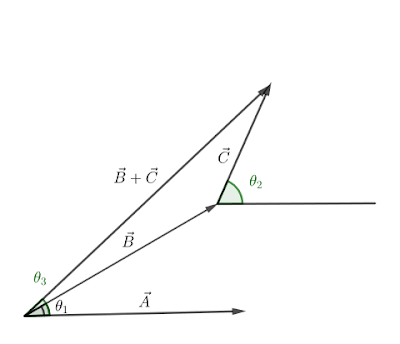Featured Post
Chapter 1 Vector Analysis: Problem 1.1
- Get link
- X
- Other Apps
Problem 1.1: Using the definitions in Eqs. 1.1 and 1.4, and appropriate diagrams,
show that the dot product and cross product are distributive,
a) when the three vectors are co-planar.
b) in the general case.
Solution:
Eq$^n$ 1.1
$$\vec{A}\cdot \vec{B} = |A||B| \cos\theta$$where $\theta$ is the angle between the vectors $\vec{A}$ and $\vec{B}$
Eq$^n$ 1.4
$$\vec{A}\times \vec{B} = |A||B| \sin\theta \hat{n}$$where $\theta$ is the angle between the vectors $\vec{A}$ and $\vec{B}$, and $\hat{n}$ is a unit vector normal to both $\vec{A}$ and $\vec{B}$.
We have to show that:
$$\vec{A}\cdot (\vec{B}+\vec{C}) = \vec{A}\cdot \vec{B}+\vec{A}\cdot \vec{C}$$
$$\vec{A}\times (\vec{B}+\vec{C}) = \vec{A}\times \vec{B}+\vec{A}\times \vec{C}$$
$a) $ When $\vec{A}$, $\vec{B}$ and $\vec{C}$ are co-planar.
$\theta_1$ and $\theta_2$ are the angles the vector $\vec{B}$ and $\vec{C}$ makes with the $\vec{A}$ respectively.
To get $\vec{B}+\vec{C}$ put the tail of $\vec{C}$ on the head of $\vec{B}$.
Let $\theta_3$ be the angle the resultant $\vec{B}+\vec{C}$ makes with the $\vec{A}$.
Draw the components of $\vec{B}, \vec{C}$ and $\vec{B}+\vec{C}$ along $\vec{A}$.
From eq$^n$ 1.4 this is nothing but,
$$\vec{A}\times (\vec{B}+\vec{C}) = \vec{A}\times\vec{B}+\vec{A}\times\vec{C}$$
$b) $ For the general case.
As suggested by the author of the book, you should read the corresponding proof in the book G.E Hay' Vector and Tensor Analysis. Link to the book: http://bayanbox.ir/view/7717647651178235179/Hay-Vector-and-Tensor-Analysis.pdf
Consider
$\vec{A} = A_x\hat{i}+A_y\hat{j}+A_z\hat{k}$, $\vec{B} = B_x\hat{i}+B_y\hat{j}+B_z\hat{k}$, and $\vec{C} = C_x\hat{i}+C_y\hat{j}+C_z\hat{k}$
Scalar product of two vectors is given by
$$\vec{A}\cdot \vec{B} = A_xB_x+A_yB_y+A_zB_z$$
$$\vec{A}\cdot (\vec{B}+\vec{C}) = (A_x\hat{i}+A_y\hat{j}+A_z\hat{k})\cdot ((B_x\hat{i}+B_y\hat{j}+B_z\hat{k}) + (C_x\hat{i}+C_y\hat{j}+C_z\hat{k}) )$$
$$\vec{A}\cdot (\vec{B}+\vec{C}) = (A_x\hat{i}+A_y\hat{j}+A_z\hat{k})\cdot ((B_x+C_x)\hat{i}+(B_y+C_y)\hat{j}+(B_z+C_z)\hat{k})$$
$$\vec{A}\cdot (\vec{B}+\vec{C}) = A_x(B_x+C_x)+A_y(B_y+C_y)+A_z(B_z+C_z)$$
$$\vec{A}\cdot (\vec{B}+\vec{C}) = A_xB_x+A_yB_y+A_zB_z+A_xC_x+A_yC_y+A_zC_z$$
$$\vec{A}\cdot (\vec{B}+\vec{C}) = \vec{A}\cdot \vec{B}+\vec{A}\cdot\vec{C}$$
Vector Product of two vectors is given by:
$$\vec{A}\times \vec{B} = \begin{vmatrix}\hat{i} & \hat{j} & \hat{k}\\ A_x & A_y & A_z \\ B_x & B_y & B_z\\ \end{vmatrix}$$
Consider
$$\vec{A}\times (\vec{B}+\vec{C}) = (A_x\hat{i}+A_y\hat{j}+A_z\hat{k})\times ((B_x+C_x)\hat{i}+(B_y+C_y)\hat{j}+(B_z+C_z)\hat{k})$$
$$\vec{A}\times (\vec{B}+\vec{C}) =\begin{vmatrix}\hat{i} & \hat{j} & \hat{k} \\ A_x & A_y & A_z \\ (B_x+C_x) & (B_y+C_y) & (B_z+C_z)\end{vmatrix}$$
Using the property of addition of determinants:
$$\vec{A}\times (\vec{B}+\vec{C}) =\begin{vmatrix}\hat{i} & \hat{j} & \hat{k} \\ A_x & A_y & A_z \\ B_x & B_y& B_z \end{vmatrix} + \begin{vmatrix}\hat{i} & \hat{j} & \hat{k} \\ A_x & A_y & A_z \\ C_x & C_y& C_z \end{vmatrix} $$
$$\vec{A}\times (\vec{B}+\vec{C}) = \vec{A}\times \vec{B} + \vec{A}\times \vec{C}$$
Hence, proved.
If you have any doubt regarding the solution or you want solution of some problem which is not posted please let me know by commenting. This encourages me to answer more question because sometime it feels like all I am doing is just a waste. If it helps someone I will be happy to do it.
If
you have any doubt regarding the solution or you want solution of some
problem which is not posted please let me know by commenting. This
encourages me to answer more question because sometime it feels like all
I am doing is just a waste. If it helps someone I will be happy to do it.
- Get link
- X
- Other Apps






Comments
Post a Comment